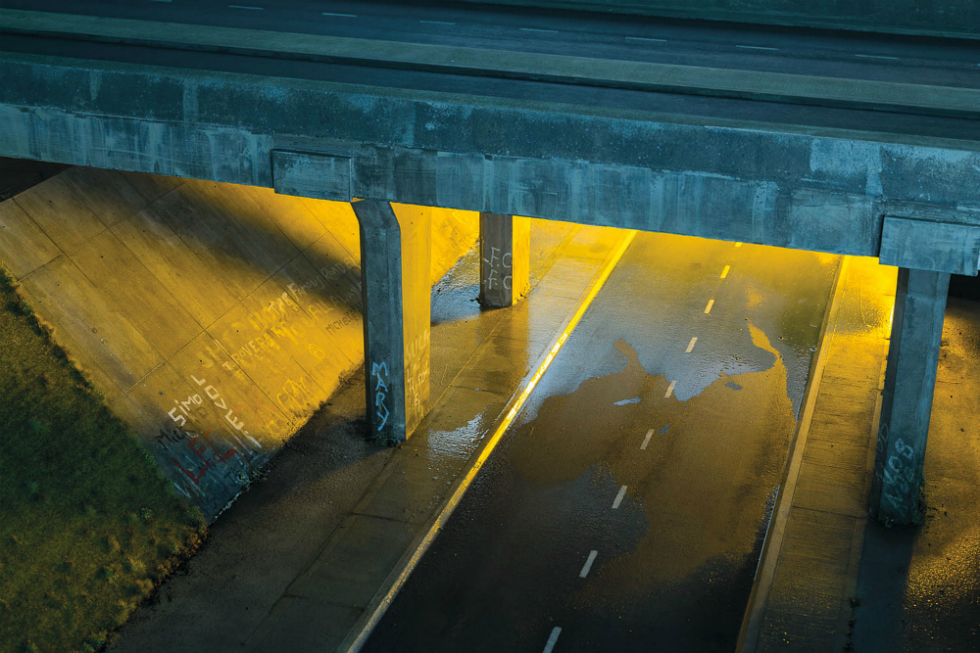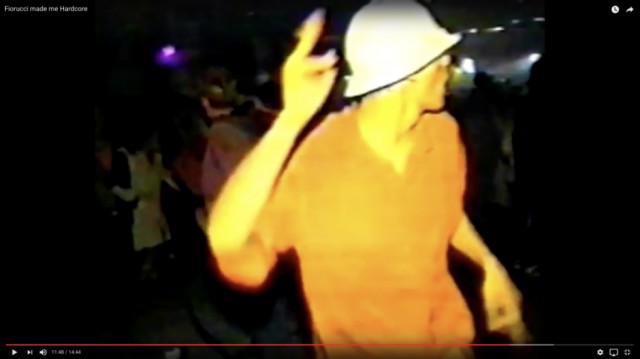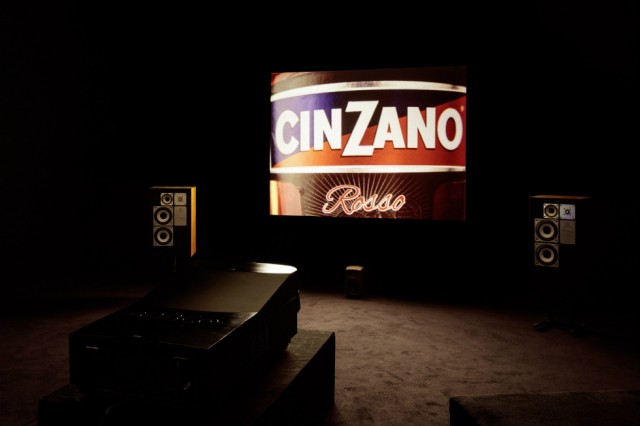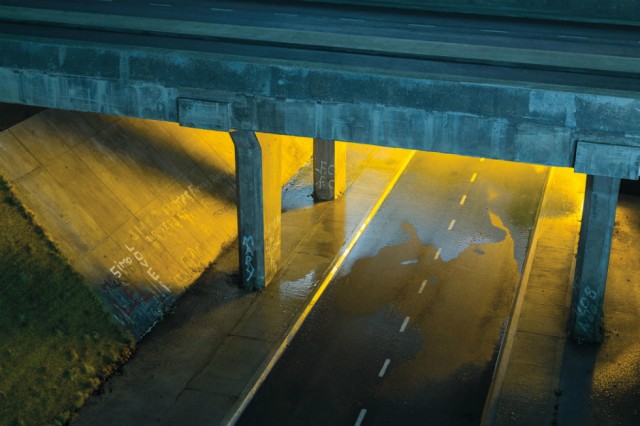The Reliquary of the (Late) 20th century: Mark Leckey’s O’ Magic Power of Bleakness

What happens when a totem of working class life and culture is recreated in an elite palace for art? Kenn Taylor reflects on Mark Leckey’s journey from Wirral underpass to the pinnacle of contemporary art…
“That over-reaching proletarian drive to be more, (I am nothing but should be everything).”
Mark Fisher
“Art inevitably arrives here to be celebrated. This is the world I belong to now. But at one point I belonged to another intelligence.”
Mark Leckey
Inside Tate Britain’s cavernous, Modernist extension, Birkenhead-born artist Mark Leckey has overseen the construction of a replica of the M53 motorway. Specifically, of the bridge at Eastham Rake. A place where Leckey spent a significant part of his youth, hanging out and having the kind of experiences that young people do, ones that burn into the memory with an intensity that few do in adulthood. The bridge has appeared with increasing frequency in his work over the past few years. Now, here, removed from context, reduced to a symbol, elevated to a monument, it is used as a canvas for the video and multimedia works that have formed the most well-known parts of Leckey’s practice.
Like Leckey, I also grew up in the shadow of the M53, the motorway’s bulk abutted my primary school, its grass verge consuming many sacrifices of footballs. Here the motorway cleaved through the heart of the various overspill estates of Birkenhead and snaked down along to Ellesmere Port, a route Leckey took himself when he moved aged nine to what was then still, just about, a booming new town of growing industries. Ellesmere Port may not be conventionally pretty, but it has a striking landscape. The elevated motorway, even still in the 1990s cutting through an oversized terrain of oil refineries, car plants and paper mills, all at night dramatically lit. A place where the houses and civic buildings of the town seemed almost an afterthought. Not unlike the Teesside landscape which so influenced a young Ridley Scott when he made Blade Runner in 1982. Much of this industry is now shuttered.
Already an admirer of the artist’s work, on hearing he’d got Tate to rebuild a bit of the M53 in its hallowed halls on the elite riverbank of Pimlico, my immediate reaction was “LOL, go ‘ead”. This was something I must see. Yet of course, I should have known the actual structure, diligently fabricated by Tate’s technical team, wouldn’t have the atmospheric power of the sodium lit exhibition poster, a still from one of Leckey’s films. Looking to indulge in the uncanny of seeing something humdrum from my own youth made large, placed on the altar of culture, was always likely to result in a degree of disappointment. Though this motorway played a far less significant role in my life than it seems to have done in Leckey’s. Here in the Tate he is reconstructing his own remembrance of things past on an epic scale. Yet, the further time passed for me from being sat crossed legged under the fake motorway, the clearer I could see what he was reaching for, how the installation embodies so much of what he has always been getting at.
The bridge serves as a base for a selection of his work from 1999 to the latest piece created for this exhibition, Under Under In, all played on a loop. Starting with his most famous work, Fiorucci Made Me Hardcore, a cut up amalgam of recovered footage of young people in urban Britain, charting the passage of musical time from Northern Soul in the 1970s to rave in the early 90s. Fiorucci has an uncanny, dream like quality, but at the same time flows with a rhythm intensely related to the cultures that it embodies. Often forgotten are the intercutting shots of post war housing estates and shopping precincts and the young people in them, forming these nascent cultures quite different from the earnest rationality the designers of such landscapes imagined. A deadpan voice reads out a list of clothing brands popular with the casuals to which Leckey once belonged. A desire for individual expression and colour away from the mass concrete and brick of Modernism. A desire that still ends up with uniformity to an extent, though no more or less than most subcultures. In Fiorucci, too, the occasional glimpse of the possibility of transcendental feeling despite everything – and many more at least reaching for it. The potential for magic in bleakness. Northern Soul danced to by industrial workers, rave danced to by their unemployed children. Decades are cut through in 15 minutes.

The next piece is Dream English Kid, 1964–1999 AD, another filmic collage. This one more personal to Leckey, exploring his own memories of time passing through found and created footage. A portrait of the artist through the images and culture that made him who he is. In Dream English Kid, the optimism of the 1960s abounds at the opening, from the images of the space race and the single twang of a Beatles chord, cutting to that more day-to-day vision of the future from that era – the ever flowing path of concrete, steel and tarmac, the motorway. A bright white sun shines down on it as Leckey overlays a fractured version of Harold Wilson’s ‘White Heat of Technology’ speech that talked about the optimistic potential for socialism driven by modern technology. Good Quality Well Paid Jobs and Better Homes in Bright New Town Britain. Few people remember Wilson actually grew up in Wirral and spent his career as a Merseyside MP. Ellesmere Port and many places like it were at the heart of Wilson’s dream. A record player spins. A chrome hubcap spins. The post war dream moving forward fast.
In the book of this exhibition, there is a picture of the first Vauxhall car made in the manufacturer’s new Ellesmere Port plant, rolling out during the same period that Leckey was born. It was then, and for some time after, the largest employer in the whole of Wirral. Across the UK, many families moved, or were moved, along the motorways, promised a better life in far out new towns and overspill estates with new industries. All intended to replace the old darkness of inner-urban Victorian landscapes. Landscapes like the now long-gone Liverpool sugar refineries of Henry Tate. The fortune from which paid for this very gallery and a packet of whose sugar is lingered over in Dream English Kid. How soon though that dream died, the workforce of the Vauxhall plant more than halving by the 1980s and a host of negative social impacts cascading out from that. The populations of these areas then often written off and blamed for the arrogance and failures of others. The ghosts of lost industries, broken promises and hopes that were too rigidly cast in concrete still haunt much of the UK.

Dream English Kid shifts too from the warm, sunny white heat of the dream to the sodium lit, dirty, graffiti covered reality. The emergence of a new working class youth culture inside of the shell of the increasingly crumbling Modernist vision. In the film, urban decay grows. Amongst deteriorating brick and concrete, just a snatch of colour from a Benson and Hedges shop sign. The red glow and grey dust of a feared nuclear winter. A bottle of Cinzano and dancing. The interrelationship and disconnect between day to day life and geopolitics. Dream English Kid then moves to Leckey’s squat life in late 80s London, the undercurrent of culture carrying on in the cracks after Thatcher’s victory. The strange new alienation and optimism of the approach of the millennium and the empty threat of Y2K. As Leckey’s memories become sharper, more contemporary, the intensity of the film fades.
Under Under In is the most recent piece, produced for this show and perhaps the most expansive. An extensive multimedia work, featuring young actors, dressed in casuals. Again, uncanny, they mess around, but in a strangely alien way, later contorting their bodies to ‘recreate’ the shape of the bridge. It’s now no longer a dream of a bright future, nor the underground base of young subversion, but a monument of uncertain origin, site of rituals unclear. “You’re away with the fairies!” is shouted at one point. A Merseyside phrase frequently said from adults to children who dare to question cold, dead, decaying perceptions of the world in any way. Leckey talks in interviews of a supernatural experience he had under the bridge as a child. It being unclear if his cleansing of doors of perception was induced by the sonic vibrations from cars overhead, fumes from industry, or just his own imagination.
It seems the further Leckey travels from his youth on the urban fringes of industrial towns, the more he reaches back into it. The more successful he his, the greater the complexity and sophistication with which he can reconstruct his own memories and snapshots of the cultures of the time he has passed through, cultures in the past rarely paid heed to in the mainstream art world. Leading on to now, one of the foremost art palaces investing in this huge replica motorway and complex multimedia production. Yet the further he reaches back, the more elaborate the recreation, the more distant it feels. Under Under In is I think the least resonant of the three pieces.
Like so many born away from cultural power, Leckey worked a long time before he was heard in the place where art is acknowledged and recorded in the official annals. Yet on reaching that point, the more he is listened to, admired and platformed, perhaps the greater his realisation that the most important stuff remains out there, in places that continue to be ignored and talked over. The harder perhaps it is for him to reach back and grasp something that is never quite there, really, that magic. As the DJ Shadow record says, You Can’t Go Home Again.
Jeremy Deller, another artist with a deep interest in the culture of dance music, is of the same generation, but, as he freely admits, a far more privileged background. Leckey and Deller’s paths of experience intermingled in London squat culture, where wealthy ‘slummers’ and the working class in the arts once crossed over, but no longer. Deller seems more interested in placing that culture formally in an art historical background. Leckey’s response is more emotional, intuitive. One inside reaching out, one outside reaching in. Yet both respecting one of the most important aspects of culture of the last 30 years.
As Deller puts it in his film Everybody in the Place, though, we should not forget that the hedonistic youth culture of rave was also in part of an admission of failure. Hedonism as a reaction against the state when it became clear they could not change its structure. The time when the dream of the White Heat of Technology bringing a stable utopia of everyday life, changed into the dream of a temporary White Heat from Technology, the fleeting utopia of a rave in an abandoned warehouse or airfield. The pattern endlessly repeated to escape the cold tomorrow that reminds us of the decay of the everyday.
There’s something particular about being an artist from one of the many unloved, fringe places, where access to art and the ability to be creative is all the more important due to scarcity, discouragement and narrowness of stimulus. Especially pre-Internet. Romance and intrigue are in the eye of those who hold it and project it. The bleaker the situation, the harder the gnashing desire for magic, the deeper the thirst for colour and stimulation in whatever form it can be found. Leckey’s first monograph, On Pleasure Bent, has a brilliant choice for its cover, the alluring gold of a Benson and Hedges cigarette packet. In the late 20th century, cigarettes and stimulation and socialising and the close but always unobtainable magic glow of golden consumerism promised by packet and magazine, bus stop and billboard. B&H, Cinzano or whatever. A need to be away with the fairies. This intense craving never appreciated by those for whom art, stimulation and opportunity was not a dearth, but a deluge.
If like Leckey, you become one of the rare people who do get to fill marble halls with your imagination, why not tell people about what you are and where you are from? See people sit amongst it in appreciation of something few would be able to point to on a map. Demonstrate that such a place has its own drama and as much capacity to drive a fevered imagination and be worthy of depiction in culture as anywhere else. I see this too in the work of George Shaw, his paintings of the Tile Hill estate in Coventry he grew up on, imbued with the intensity of feeling that is more conventionally draped over the skyscrapers of Manhattan, the monuments of Rome or the streets of Berlin.

Yet if Leckey was haunted at the bridge, something about this bridge should haunt us. This installation is, to quote his Exorcism of the Bridge @ Eastham Rake, a reliquary of the 20th century, containing now, finally, venerated and established relics of the past for us to appreciate. Yet however alluring nostalgia can be to all of us, I still pay heed to the historic view of nostalgia being a disease, a comfort that ignores the raw and uncomfortable of the here and now. This is all a culture of the past, no more or less valid, or important than what young people create and experience now. Leckey reminds us that such cultures and experiences often don’t have their importance respected or acknowledged. That’s if they’re not actively demonised. This was just his and it deserves its elevation to monumental status.
But in absorbing a bit of the magic he recreates we shouldn’t forget that the social decay that accompanied the rise of these past youth cultures remains. The layers of paint applied to the bridge during the New Labour era have long flaked off. The future of the Vauxhall Motors plant at Ellesmere Port, having shrank even further in recent years, now hangs in the balance, overshadowed by Brexit, lost in the horse trading of the global motor industry. And little of the urban regeneration that has recharged Britain’s inner cities, many now increasingly reoccupied by the middle and upper classes, has reached out to the overspill estates and new towns where former inner city dwellers were moved. Young people living in Ellesmere Port and all the many places like it, are no doubt still having just as intense experiences. Loitering in underpasses, now both physical and digital. But will they be afforded the same opportunities as Leckey was, who was able to redo his O-Levels aged 20 and attend art college at no cost. Things which helped him to (eventually) be heard and represent the culture he came from. Will they get the opportunity to fill the marble halls of the Tate in future with their own dreams and memories?
Kenn saw Mark Leckey: O’ Magic Power of Bleakness at Tate Britain in 2019, where it ran until 5 January 2020
Images: Dream English Kid, 1964–1999 AD 2015 (still) Courtesy of the artist © Mark Leckey; Fiorucci Made Me Hardcore 1999 (still) Courtesy of the artist © Mark Leckey; Installation views of Dream English, Kid 1964–1999 AD at Cabinet, London, 2015 Photo: Mark Blower





